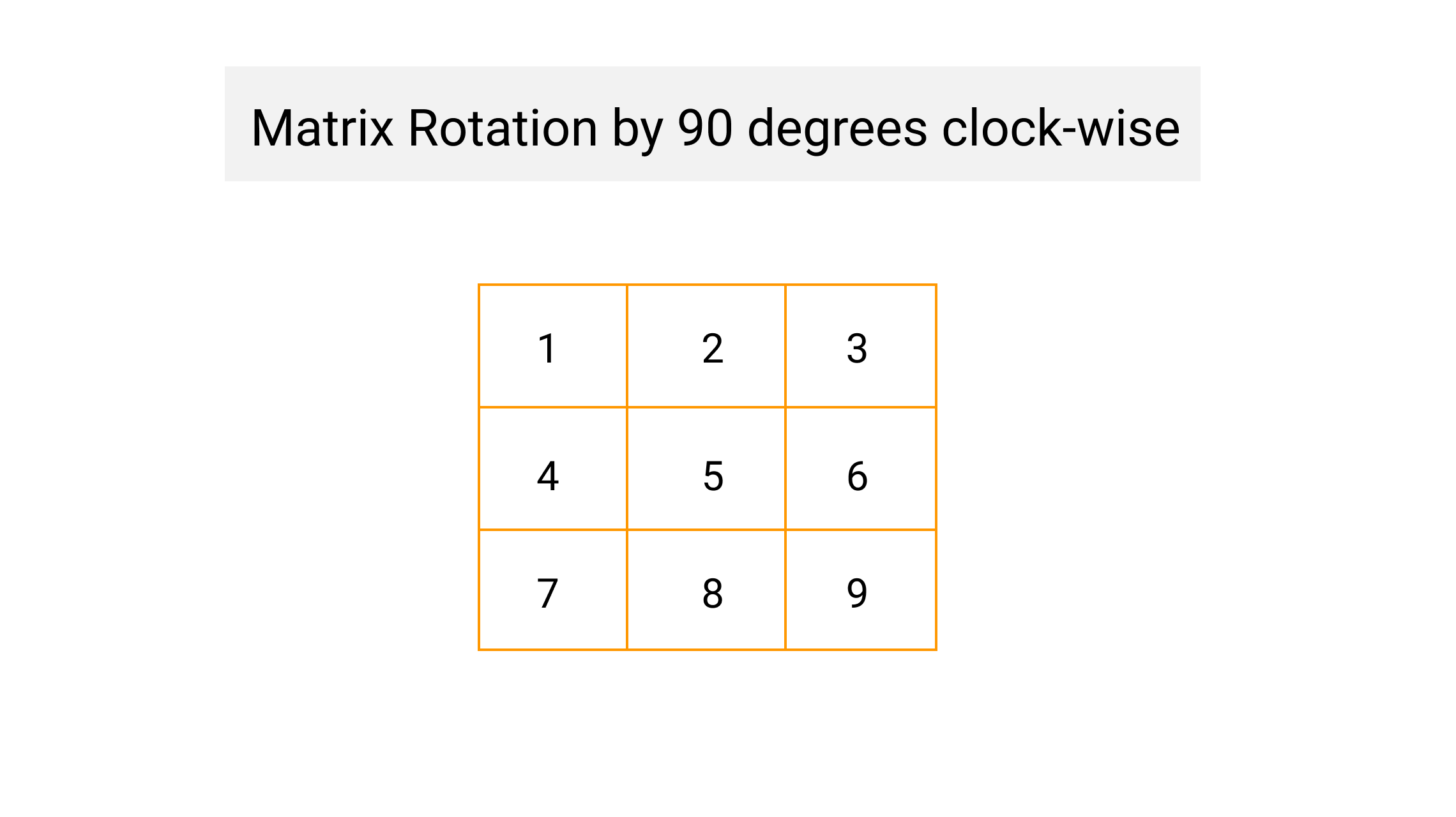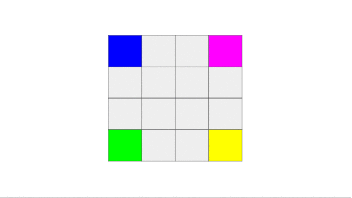Rotate Matrix

Difficulty: Medium
Asked in: Google
Understanding the problem
You are given an N x N 2D matrix representing an image. Write a program to rotate the image by 90 degrees (clockwise).
Problem Note
- You have to rotate the image in-place, which means you have to modify the input 2D matrix directly and you can't use extra space.
Example 1
Input:
[
[1,2,3],
[4,5,6],
[7,8,9]
]
Output: Rotate the input matrix in-place such that it becomes:
[
[7,4,1],
[8,5,2],
[9,6,3]
]Example 2
Input:
[
[ 5, 1, 9,11],
[ 2, 4, 8,10],
[13, 3, 6, 7],
[15,14,12,16]
]
Output: Rotate the input matrix in-place such that it becomes:
[
[15,13, 2, 5],
[14, 3, 4, 1],
[12, 6, 8, 9],
[16, 7,10,11]
]You may try to solve the problem here .
Solutions
We will be discussing two approaches for the problem
- Transpose Matrix and Reverse Rows
- In-place Rotate
Transpose and Rotate
The idea is to first, transpose the matrix and then flip it symmetrically. For instance,
1 2 3
4 5 6
7 8 9
after transpose, it will be
swap(matrix[i][j], matrix[j][i])
i.e. make the rows as columns and columns as rows.
1 4 7
2 5 8
3 6 9
Then flip the matrix along the vertical axis.
swap(matrix[i][j], matrix[i][N-1-j]
7 4 1
8 5 2
9 6 3Visualization

Solution steps
- Take the transpose of the matrix with m rows and n columns.
-
Go to every pair of
iandjindices within the range of its length. -
swap
matrix[i][j]withmatrix[j][i].
2. Reverse each row of the matrix
-
Inplace rotate each row by swapping
matrix[i][j]withmatrix[i][N-1-j]
Pseudo Code
// Driver function, N represent the dimensions of matrix
void rotateMatrix(int[][] matrix, int N) {
// take transpose of matrix
for(int i = 0 to N){
for(int j = i to N){
int temp = matrix[i][j]
matrix[i][j] = matrix[j][i]
matrix[j][i] = temp
}
}
// perform rotation of each row
for(int i = 0 to N){
for(int j = 0 to N/2){
int temp = matrix[i][j]
matrix[i][j] = matrix[i][N-1-j]
matrix[i][N-1-j] = temp
}
}
}Critical Ideas to Think
- How did we find the transpose of the matrix?
-
Why are we performing swapping till
N/2while rotating each row? -
Will this algorithm work if the matrix dimension is not
N x N? - If we first perform the rotation of rows and then perform its transpose, then will the algorithm work? If yes, Why?
- What changes will we make to perform the rotation in the anticlockwise direction?
Complexity Analysis
Time Complexity — O(N²) (Why?)
Space Complexity — O(1) Due to in-place rotation of matrix.
In-place Rotate
If you will notice the input and resultant matrices, you will find that,
The first row of the source matrix is the last column of the destination matrix. Similarly, the second row of the source matrix is the second last column of destination and so … on the last row of the source is the last column of the destination matrix.

So, if we consider the outer most elements of the matrix as a layer then a
N x N
matrix will have
ceil(N/2)
square cycles. For example, a
6 x 6
matrix will have
3
cycles. The first cycle is formed by its 1st row, last column, last row and 1st column. The second cycle is formed by 2nd row, second-last column, second-last row and 2nd column and so on. (You can take help from the above figure where N = 5)
The idea is for each square cycle, we swap the elements involved with the corresponding cell in the matrix in clockwise direction i.e. from top to right, left to top, bottom to the left and from right to the bottom, one at a time.
Visualization

Solution Steps
-
Consider all squares/cycles one by one, there will be maximum Ceil(
N/2)cycles for anyN. - For each cycle, store the first element of the top row in a temp variable, then perform
- matrix[low][i] = matrix[i][high]
- matrix[i][high] = matrix[high][N-i-1]
- matrix[high][N-i-1] = matrix[N-i-1][low]
- matrix[N-i-1][low] = temp
Pseudo Code
void rotateMatrix(int[][] matrix, int N) {
int layer = 0
while(layer < N/2){
int low = layer
int high = N - 1 - layer
for (int i = low to high){
// Swapping elements after each iteration in clockwise
int temp = matrix[low][i]
matrix[low][i] = matrix[N-1-i][low]
matrix[N-1-i][low] = matrix[N-1-low][N-1-i]
matrix[N-1-low][N-1-i] = matrix[i][N-1-low]
matrix[i][N-1-low] = temp
}
layer = layer + 1
}
}Critical Ideas to Think
-
Why there could be maximum of
N/2cycles for a particularN? - How are we performing rotation for each cycle?
- What changes will you make to make the rotation anti-clockwise?
Complexity Analysis
Time Complexity — O(N²)
Space Complexity — O(1), Rotation is performed in-place.
Comparison of different solutions

Suggested problems to solve
- Take transpose of M x N size matrix in-place
- Rotate a Matrix by 180 degree
- Rotate the matrix clockwise by K times
- Rotate each ring of matrix anticlockwise by K elements
Please comment down below if you find an improvement in the above explanation.
Happy Coding!





